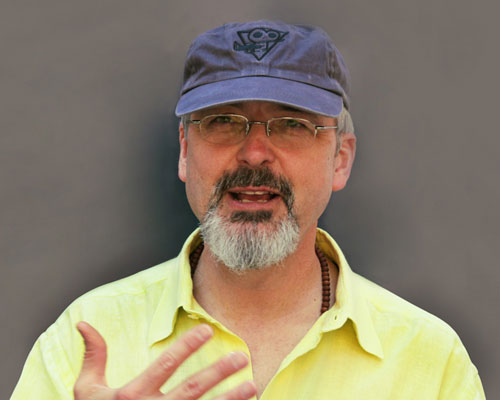bill viola at the venice art biennial, 2007portrait© designboom
we met bill viola in venice, on june 9th, 2007.
what is the best moment of the day?
twilight is the most important moment of the day because that isthe time when nature herself is unstable. twilight is so beautiful because the sun is going down and it’s getting darker. the sun has set but it’s still light out. the daytime world made up of the creatures that live in the day, the dogs, birds, squirrels, trees, people (they live in both day and night) and plants all go to sleep. while they’re preparing to go to sleep, the animals and the living beings from the night are waking up. this doesn’t happen in a neat little perfect line, it’s actually a messy transition where nature is still showing us light from the day but, the night has not fully arrived. the two are kind of touching each-other and some animals from the night time are coexisting with animals from the daytime; it’s a very special moment. the beauty of it is the instability. this also occurs at sunrise too. so I’m interested in moments and places of instability: thresholds of transition in between two things. for example, my favourite times of year are springtime and the autumn. in the springtime, the flowers try to come up but sometimes it’s still snowing. in the autumn, you have the trees holding on to their life, some of them are loosing their leaves and some are green. those are the kind of moments I like, where things are not clear and you can’t decide between this and that. the age of computers is a very dangerous time for us because computers work on ‘yes or no’, ‘1 or 0’. there’s no maybe, perhaps or both, it’s only yes or no. I think this is affecting our consciousness, because nature doesn’t work that way. nature works on maybe and poetry comes from maybe, not from a hard fixed order. those kind of transitions and thresholds are very very important in my work.
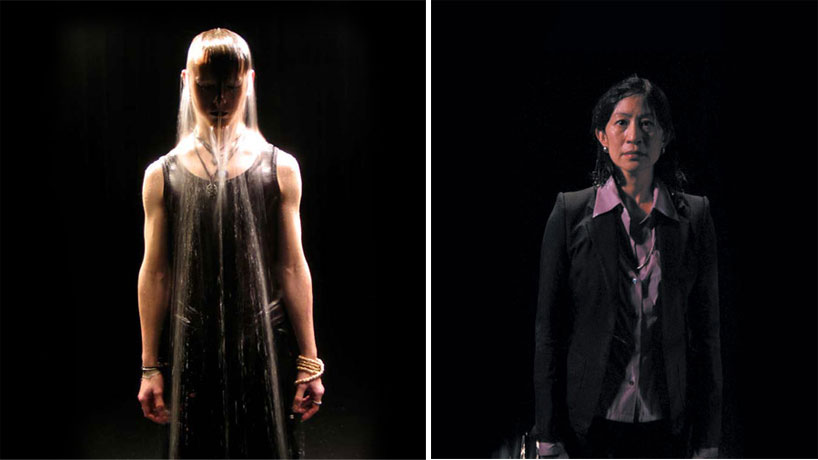
ocean without a shore’, 2007 – video still© bill viola, courtesy the artist
what kind of music do you listen to?classical music, tibetan music, german and american music from the cinema, …
what books are on your bedside table?the books I have right now are a book on chinese sung dynasty poetry, which is I love. I have a book of the biography of the life of buddha. I have a magazine in my study, a the technical journal of the new high definition video cameras, which I keep with me. I’m also reading a book about extinctions in history called ‘waiting for the macaws’ by a scottish writer and I have a book on the paintings of giovanni bellini that I was reading before I came here. I also got a new book on alberto giacometti, who has become one of my favorite artists, I think he’s an extraordinary artist.
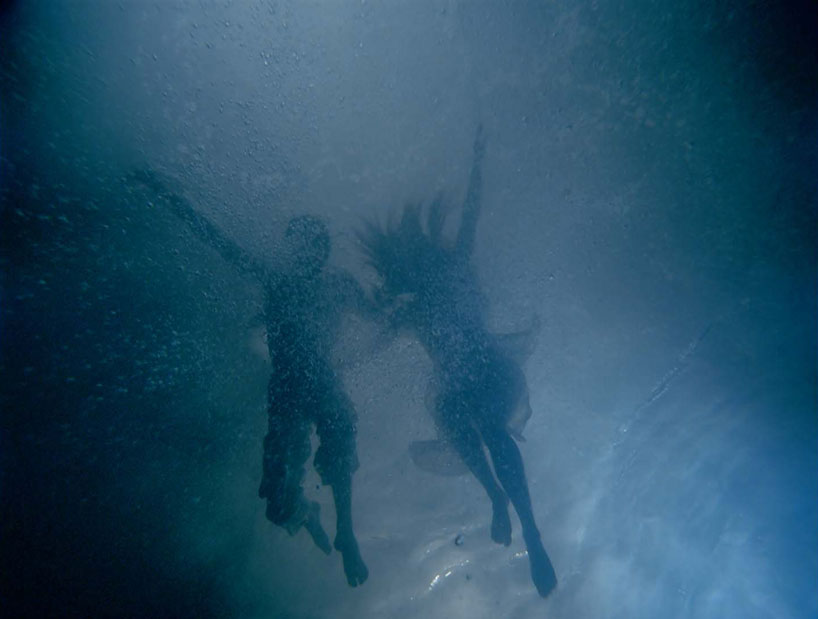
‘the fall into paradise’, 2005 – video still© bill viola, courtesy the artist
do you listen to the radio?no, not really.
where do you get your news from?new york times, internet.
I guess that you notice how women dress, do you have any preferences?simple is best.
what kind of clothes do you avoid wearing?a tie. anything that’s pretentious and uncomfortable.
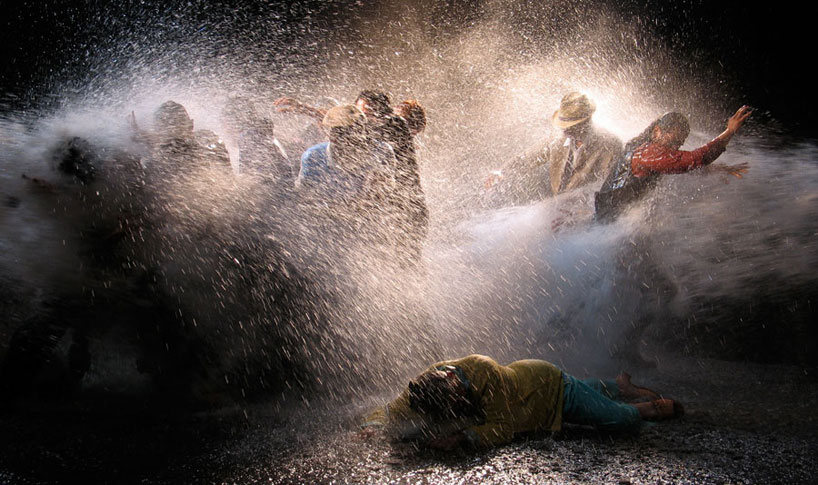
‘tempest (study for the raft)’, 2005 – video still© bill viola, courtesy the artist
where do you work on your projects?
I have a studio. I live in the los angeles area, in a town calledlong beach, california and I’ve been living there for 25 years. it’s a very quiet street that we live on. we have two children so it’s a normal neighborhood because I don’t like to live in the centre of the city or in the centre of the art scene. I always prefer to live on the side, just in the corner. so I have a studio, a big studio, a warehouse industrial space where I have some assistants. that’s where we do shooting, this piece was shot in my studio and that’s where I do my work, when I make works. but my real place to work is in a very small house across the street from our house that I rent. I have all my books, I have tables to write and of course my computer. that’s where I work because I used to work in my studio everyday, but what I found was the studio was becoming very busy. I couldn’t think quietly because there were assistants doing things and when we’re doing productions there is a lot of activity. I realized I needed a very private space because of the way I work. so what I did was, rent this house with only three rooms. it’s very quiet, I have no telephone and that’s where I really think and develop my ideas. then when I’m absolutely ready with a new idea that I’ve really really worked on very very severely, I go to my studio and Iexplain it to everybody. I say this is what we are going to make and then we start working. but if I don’t have an idea, I don’t go to my studio.
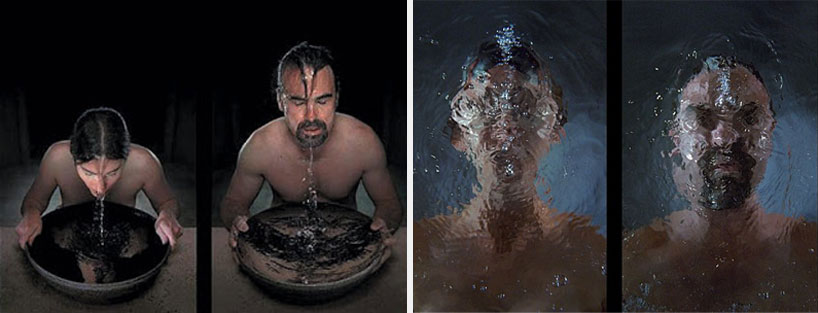
left: ‘purification’ 2005 – video still© bill viola, courtesy the artist
right: ‘dissolution’, 2005 – video still© bill viola, courtesy the artist
could you describe your style as a good friend of yours might?we have all come from a place of the unborn and we are all here for a short period of time. we have to cross a threshold of water and light to arrive and to leave. we will ultimately all go back to this eternal non-spatial, non-temporal world of potentiality. a lot of my work deals with questionslike this, of giving birth, death and human transition.
what are the main characteristics of the work you are showing here?the main characteristics of my work here are light, water and time. the images concern people who are approaching from a distant place, a dark shadowy place. this world that has no colour and has very little detail or visibility. as they approach us they become more and more clear, present and individual. they become more individualized and then at a certain point they cross a threshold, an invisible threshold. this threshold is made up of water, which is pouring from above, across the image. the water cannot be seen because it’s a special kind of water system which has no disturbance, except at the bottom. as they cross the threshold of water, they also meet a second surface made of light. when they pass through this threshold, they disturb the water and it sprays and falls everywhere. at that moment they become materialized, they become colour, detail and substance. the body becomes present and it’s like a kind of birth as they arrive in our space on this side of the water. the sound gives us the impression that they’re in the room, because sound occupies space. they arrive with light and with sound. the sound touches us in the room, becoming part of the room we’re standing in. then they spend a short amount of time with us, recovering and gathering their senses from this very strong transition. they then realize they have to go back, their time is up. they must turn their backs on us and walk back through the threshold of water and light, back into the world of shadows. that to me is the ultimate description of human existence.(see the designboom report on bill viola at the san gallo church,venice art biennial, 2007)

‘emmergence’, 2002 – video still© bill viola, courtesy the artist
can you describe an evolution in your work?
the evolution in my work has been very tied to the evolution oftechnology. I first touched a video camera in 1969 and the first videotape I made was in 1970. the medium was very very different, it was very primitive, low quality and black and white only. so basically, I committed myself to video when I wasyounger in art school. when I first touched a video camera,something inside me said I will do this the rest of my life. don’t ask me why, but I had a vision of video moving out into the world, into the culture, very clearly. I could feel it, so I knew I would do it forever. technology’s changing so much, it would be as if a painter learned to paint with only a limited set of colours. then every year there were more colours, more techniques and that’s what happened in video. this piece uses the newest high definition video camera that’s made, one that came out three months ago. it’s a really advanced camera that is on the same level and quality as 35mm film, probably little better. that’s the colour camera in this piece. the black and white camera in this piece is a camera from 35 years ago, that is a security camera. so those two images are meeting, that’s my palate right now, that’s the range that I have to work with. grainy, dark, black and white only, analog video, all the way up to the latest digital, high-definition, cinema quality camera. I don’t see an end to this process, every year I have new possibilities, technically and creatively. so I think the most important thing is to keep up in yourself, to make sure that you’re always growing. you canhave the best technology in the world, but if you don’t have an idea, if you don’t have a feeling of moving forward in life, of trying to do something you don’t know… because we always want to do things we know, we feel very comfortable, but you have to always make sure there’s a place for something you don’t know. you have to push yourself and that for me has been the journey.
when you were a child did you always want to become an artist?yes, I don’t know life really without art.I’ve never not been doing art. the very very first day I was in kindergarten, when I was five years old, they gave us finger-paints. I was making a finger painting, all the children were making finger-paintings and I made a tornado, quite a nice tornado. the teacher came along and said ‘ohhhh, look what billy did’, she held it up and of course because I was very shy, I was hiding under the table and all red. I was so shy, she held it up and showed everybody, putting it on the wall. from that day on, I was the class artist in every class growing up. all my pictures were always on the wall in the class right until university and now. so really I’ve never in my life, not done art. I’ve always done art from when I was very very little, I’ve always had some kind of exhibition, on the wall of theclassroom or in the museums.
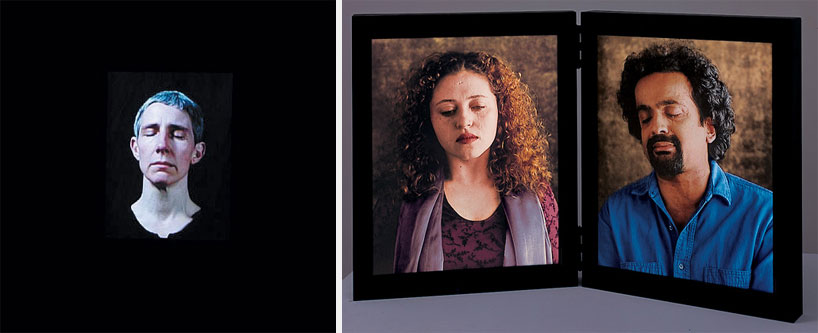
‘remembrance’, 2002 – video still© bill viola, courtesy the artist
is there any artists from the past that have influenced you or that you particularly appreciate the work of?I have colleagues and I see them in exhibitions like this, but I don’t follow the contemporary art very closely. so I’d have to say people like alberto giacometti, joseph beuys, mark rothko, I like their work very much. most of the time I’m really interested in historical art from the past, particularly italian renaissance. some of the baroque period too, but for me northern and southern renaissance art is very a special moment because it really was the creation of the optical image. the first time that painters,since the ancient greeks, based their work on how the eye sees the world.
do you have any advice for young artists?my advice for the young video artists is to make sure you take the lens cap off the camera before you push the button. because I didn’t do this all the time. also to learn from the camera, you must keep your eye open without judgment. cameras do not make judgments. they receive all the light equally and we have to keep our minds and hearts open to be completely objective, feeling everything equally good and bad, violent and peaceful, light and dark. all opposites are necessary for life and so you shouldn’t make a value judgment on what you are experiencing. video can teach us how to see with an open eye.
is there ethics in art?yes, there is, there’s ethics in art. there’s a big responsibilitywhen you make an image and put it out in the world. I think the guide for me in this is a tibetan master who was killed by the chinese in the 1960’s when the cultural revolution happened in tibet. he said that all activity should be done with the intention to help, not hurt others.
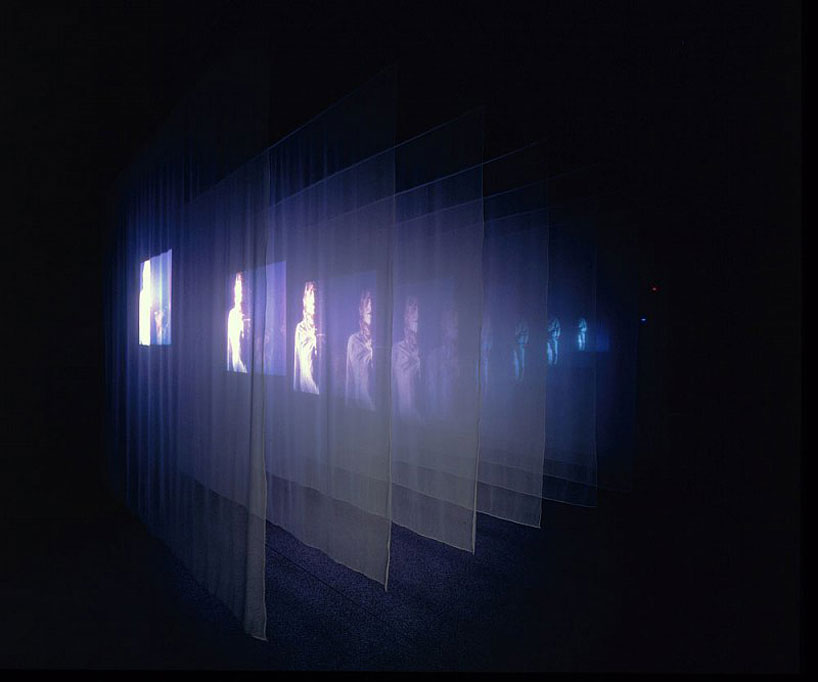
‘the veiling’, 1995- video still© bill viola, courtesy the artist
is there anything that you’re afraid of regarding the future?no, I have no fear of the future at all. I think the future will be a better place. I think we will get over this kind of disruption, disturbance and tension we feel right now because of this medium. because of communications technology, people are closer together then ever before. when I was a child looking at the tv, I didn’t know what arabs look like and know they’reeverywhere. the cultures are growing together and that’s causing this kind of tension and instability. I think if I look forward in the future, it’s also allowing us to touch each other. I think we just have to get the politicians out of the way, we have to get the churches, the religious institutions out of the way. they are the cause of the problem. they’re holding onto their beliefs and their ideas and they’re manipulating the societies. we have to let people talk directly to people. in that sense, the most important element in this globalization process is the artist. because artists speaks in a universal language that has no boundaries. between past and present, between east and west, art is all equal. if the artists don’t get a voice in this new global system, there will be trouble because art is the universal language of mankind.

